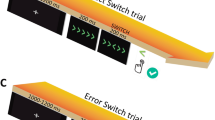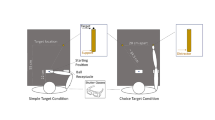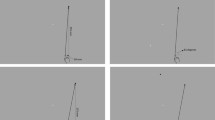Abstract
The ability to correct reaching movements for changes in target position has been described as the hand’s ‘automatic pilot’. These corrections are preconscious and occur by default in double-step reaching tasks, even if the goal is to react to the target jump in some other way, for instance by stopping the movement (STOP instruction). Nonetheless, corrections are strongly modulated by conscious intention: participants make more corrections when asked to follow the target (GO instruction) and can suppress them when explicitly asked not to follow the target (NOGO instruction). We studied the influence of a cognitively demanding (auditory 1-back) task upon correction behaviour under GO, STOP and NOGO instructions. Correction rates under the STOP instruction were unaffected by cognitive load, consistent with the assumption that they reflect the default behaviour of the automatic pilot. Correction rates under the GO instruction were also unaffected, suggesting that minimal cognitive resources are required to enhance online correction. By contrast, cognitive load impeded the ability to suppress online corrections under the NOGO instruction. These data reveal a constitutional bias in the automatic pilot system: intentional suppression of the default correction behaviour is cognitively demanding, but enhancement towards greater responsiveness is seemingly effortless.



Similar content being viewed by others
References
Boot WR, Brockmole JR, Simons DJ (2005) Attention capture is modulated in dual-task situations. Psychon Bull Rev 12(4):662–668
Brenner E, Smeets JBJ (1997) Fast responses of the human hand to changes in target position. J Motor Behavior 29(4):297–310
Cameron BD, Franks IM, Enns JT, Chua R (2007) Dual-target interference for the ‘automatic pilot’ in the dorsal stream. Exp Brain Res 181(2):297–305
Cameron BD, Cressman EK, Franks IM, Chua R (2009) Cognitive constraint on the ‘automatic pilot’ for the hand: movement intention influences the hand’s susceptibility to involuntary online corrections. Conscious Cogn 18(3):646–652
Castiello U, Paulignan Y, Jeannerod M (1991) Temporal dissociation of motor-responses and subjective awareness—a study in normal subjects. Brain 114:2639–2655
Cressman EK, Franks IM, Enns JT, Chua R (2006) No automatic pilot for visually guided aiming based on colour. Exp Brain Res 171(2):174–183
Day BL, Lyon IN (2000) Voluntary modification of automatic arm movements evoked by motion of a visual target. Exp Brain Res 130(2):159–168
Desmurget M, Epstein CM, Turner RS, Prablanc C, Alexander GE, Grafton ST (1999) Role of the posterior parietal cortex in updating reaching movements to a visual target. Nat Neurosci 2(6):563–567
Doyle D, Walker R (2001) Curved saccade trajectories: voluntary and reflexive saccades curve away from irrelevant distractors. Exp Brain Res 139(3):333–344
Fisk JD, Goodale MA (1985) The organization of eye and limb movements during unrestricted reaching to targets in contralateral and ipsilateral visual space. Exp Brain Res 60(1):159–178
Goodale MA, Pelisson D, Prablanc C (1986) Large adjustments in visually guided reaching do not depend on vision of the hand or perception of target displacement. Nature 320(6064):748–750
Grea H, Pisella L, Rossetti Y, Desmurget M, Tilikete C, Grafton S et al (2002) A lesion of the posterior parietal cortex disrupts on-line adjustments during aiming movements. Neuropsychologia 40(13):2471–2480
James W (1890) The principles of psychology. Dover, New York
Johnson H, van Beers RJ, Haggard P (2002) Action and awareness in pointing tasks. Exp Brain Res 146(4):451–459
Jonides J, Navehbenjamin M, Palmer J (1985) Assessing automaticity. Acta Psychol 60(2–3):157–171
Macleod CM, Dunbar K (1988) Training and Stroop-like interference—evidence for a continuum of automaticity. J Exp Psychol—Learn Mem Cogn 14(1):126–135
McSorley E, Haggard P, Walker R (2004) Distractor modulation of saccade trajectories: spatial separation and symmetry effects. Exp Brain Res 155(3):320–333
Meegan DV, Tipper SP (1998) Reaching into cluttered visual environments: spatial and temporal influences of distracting objects. Q J Exp Psychol Sect A—Human Exp Psychol 51(2):225–249
Pelisson D, Prablanc C, Goodale MA, Jeannerod M (1986) Visual control of reaching movements without vision of the limb. 2. Evidence of fast unconscious processes correcting the trajectory of the hand to the final position of a double-step stimulus. Exp Brain Res 62(2):303–311
Pisella L, Grea H, Tilikete C, Vighetto A, Desmurget M, Rode G et al (2000) An ‘automatic pilot’ for the hand in human posterior parietal cortex: toward reinterpreting optic ataxia. Nat Neurosci 3(7):729–736
Striemer CL, Yukovsky J, Goodale MA (2010) Can intention override the “automatic pilot”? Exp Brain Res 202(3):623–632
Tipper SP, Howard LA, Jackson SR (1997) Selective reaching to grasp: evidence for distractor interference effects. Vis Cogn 4(1):1–38
Van der Stigchel S, Theeuwes J (2005) The influence of attending to multiple locations on eye movements. Vis Res 45(15):1921–1927
Welsh TN, Elliott D (2004) Movement trajectories in the presence of a distracting stimulus: Evidence for a response activation model of selective reaching. Q J Exp Psychol Sect A – Human Exp Psychol 57(6):1031–1057
Welsh TN, Elliott D (2005) The effects of response priming on the planning and execution of goal-directed movements in the presence of a distracting stimulus. Acta Psychol 119(2):123–142
Welsh TN, Elliott D, Weeks DJ (1999) Hand deviations toward distracters—evidence for response competition. Exp Brain Res 127(2):207–212
Acknowledgments
A.M. was supported by a studentship from the UK Economic and Social Research Council.
Author information
Authors and Affiliations
Corresponding author
Rights and permissions
About this article
Cite this article
McIntosh, R.D., Mulroue, A. & Brockmole, J.R. How automatic is the hand’s automatic pilot?. Exp Brain Res 206, 257–269 (2010). https://doi.org/10.1007/s00221-010-2404-2
Received:
Accepted:
Published:
Issue Date:
DOI: https://doi.org/10.1007/s00221-010-2404-2




